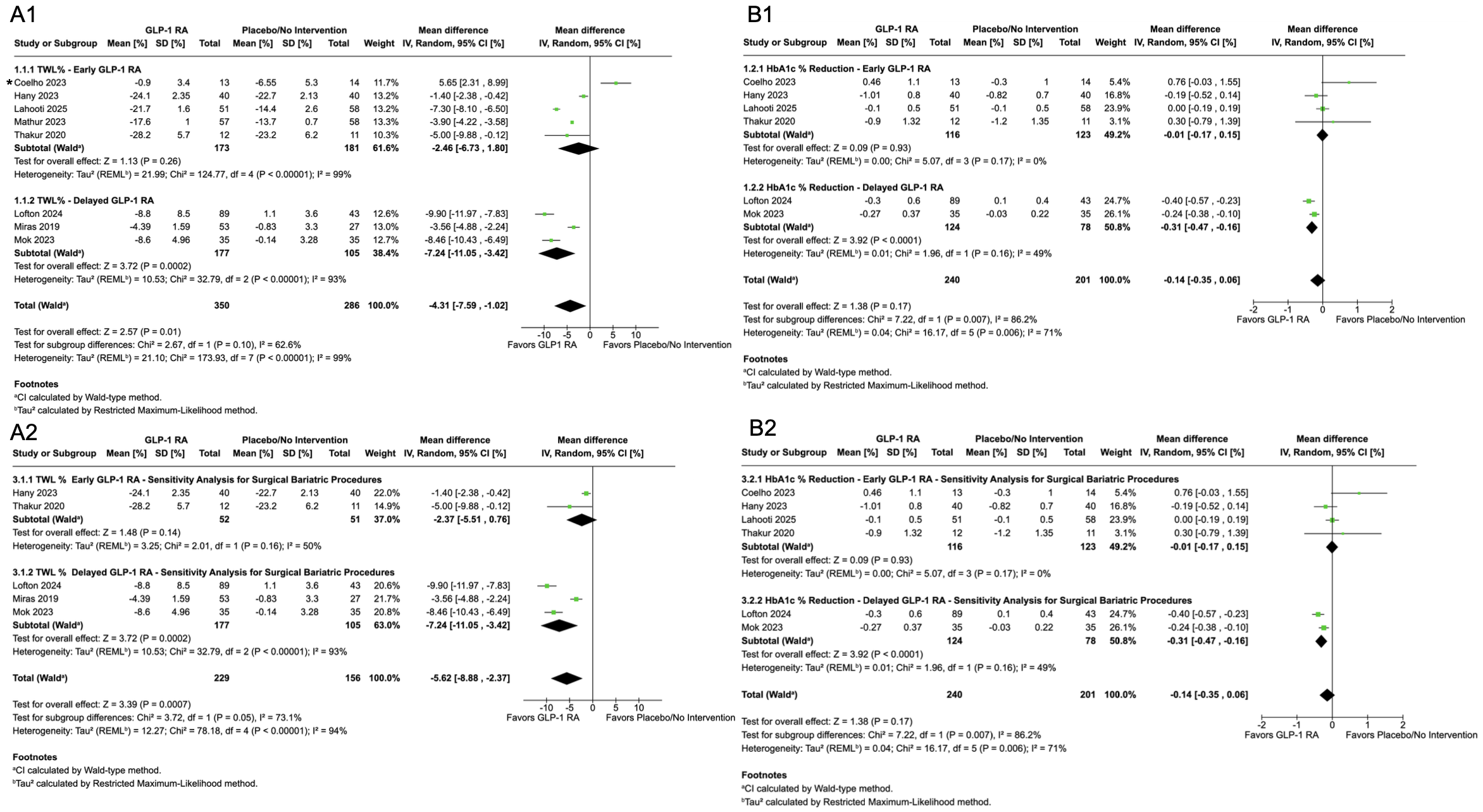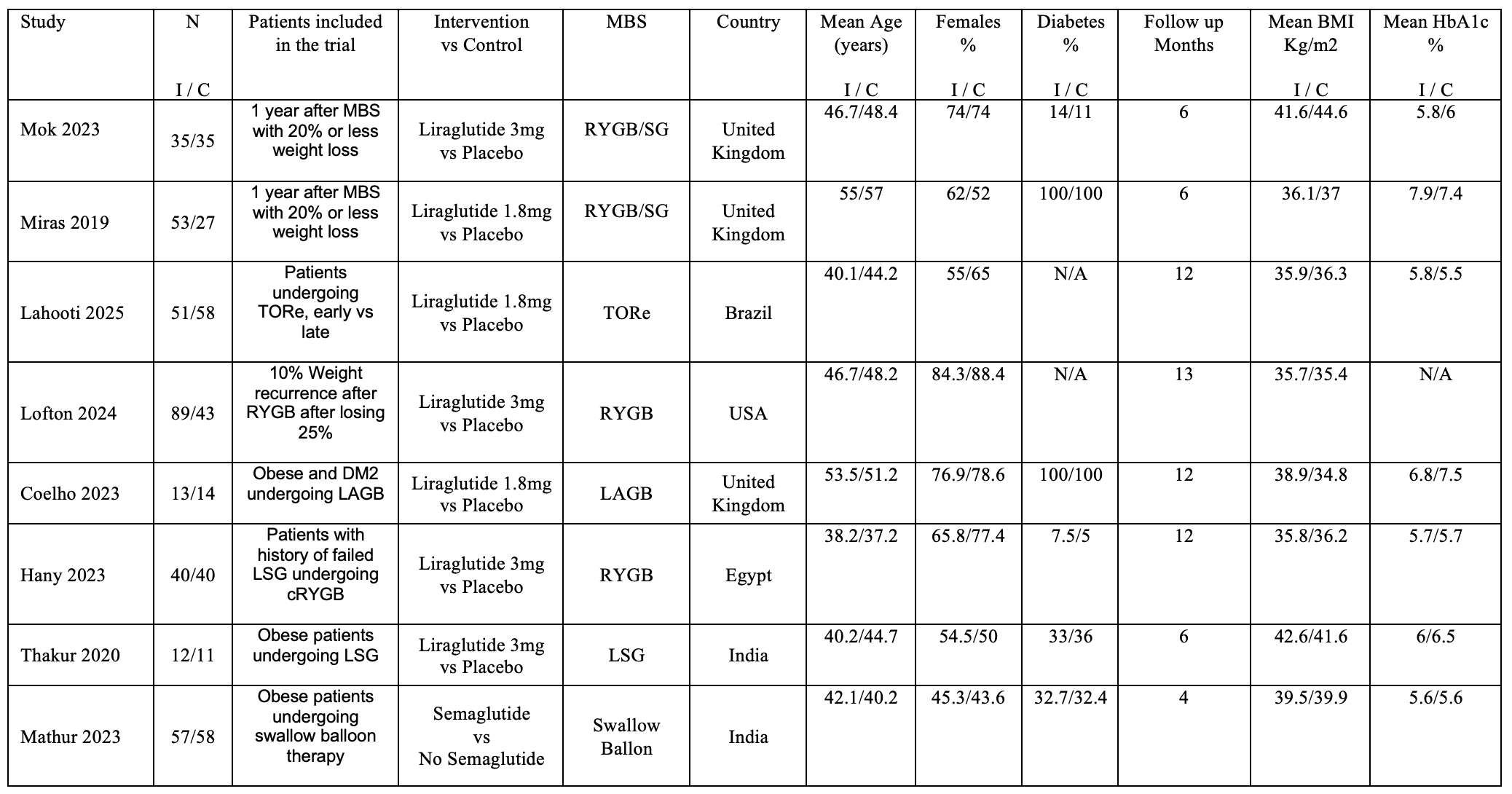Monday Poster Session
Category: Diet, Nutrition, and Obesity
P2690 - Effectiveness of Early vs Delayed GLP-1 Receptor Agonist Initiation Following Bariatric Procedures: A Meta-Analysis of Randomized Controlled Trials
Monday, October 27, 2025
10:30 AM - 4:00 PM PDT
Location: Exhibit Hall

Daniel A. Guifarro, MD
Cook County Health
Chicago, IL
Presenting Author(s)
Award: ACG Presidential Poster Award
Daniel A. Guifarro, MD1, Eleazar E.. Montalvan-Sanchez, MD2, Gloria Erazo, MD3, Ambar Godoy, MD4, Saksham Kohli, MBBS5, Maria Grba, MD5, Clive Miranda, DO6, Angelo Caputi, MD1, Sonali Paul, MD, MS, FACG7
1Cook County Health, Chicago, IL; 2Yale University School of Medicine, New Haven, CT; 3Texas Tech University Health Sciences Center, Odessa, TX; 4Indiana University, Indianapolis, IN; 5John H. Stroger, Jr. Hospital of Cook County, Chicago, IL; 6Creighton University Medical Center, Omaha, NE; 7University of Chicago, Chicago, IL
Introduction: GLP-1 receptor agonists (GLP-1 RAs) and bariatric procedures (BPs) are key strategies in the treatment of obesity. While both are effective individually, the optimal timing for initiating GLP-1 RAs following BP remains unclear. This meta-analysis evaluates the efficacy of early (≤8 weeks) versus delayed ( >8 weeks) initiation of GLP-1 RAs after BPs.
Methods: We conducted a systematic search of PubMed, Embase, and Cochrane databases to identify randomized controlled trials (RCTs) comparing GLP-1 RAs to placebo or no intervention in patients who underwent BPs (surgical or non-surgical) and assessed whether early versus delayed treatment influenced outcomes. Primary outcomes included mean differences (MD) in total weight loss percentage (TWL%) and HbA1c% reduction. We used a random-effects model and I² statistic to assess pooled outcomes and heterogeneity.
Results: Eight RCTs including 636 patients were analyzed: 350 received GLP-1 RAs, and 286 received placebo or no intervention. Among GLP-1 RA recipients, 173 started early treatment and 177 delayed treatment (mean time to treatment after BP in the delayed group was 57.4 months, SD = 29). Table 1 shows the baseline characteristics and type of procedures included. Delayed GLP-1 RA use led to a greater TWL% (MD −7.24%,−11.05 to −3.42, p< 0.001), while early initiation was not beneficial (MD −2.46%, −6.73 to 1.80, p >0.05). However, a pooled analysis of GLP-1 RA initiation irrespective of timing showed a significant benefit (MD −4.31%, −7.59 to −1.02, p=0.01). HbA1c % reduction was also greater with delayed therapy (MD −0.31%, −0.47 to −0.16, p< 0.001) but not with early use (MD −0.01%, −0.17 to 0.15, p >0.05). Leave-one-out sensitivity analysis revealed that excluding one study increased the TWL% benefit of early GLP-1 RA use (MD −4.33, −7.03 to −1.62; p< 0.01), see figure 1A. In surgical BP patients, only delayed GLP-1 RAs led to a greater TWL% (MD –7.24%, –11.05 to –3.42); the delayed group also showed a significant reduction in HbA1c (MD –0.31%, –0.47 to –0.16; p < 0.001).
Discussion: Delayed initiation of GLP-1 RAs after BPs appears to yield greater benefits in TWL% and HbA1c% compared to early use. However, sensitivity analysis suggests a benefit from early therapy as well. The timing of GLP-1 RAs may influence metabolic outcomes and delayed initiation improved both TWL % and HbA1c % reduction. Further studies are needed to evaluate the efficacy of delayed GLP-1 RAs after non-surgical BPs.

Figure: Table 1. Baseline characteristics of included studies.
Body mass index. HbA1c: Glycated hemoglobin. RYGB: Roux-En-Y gastric bypass. SG: Sleeve gastrectomy. TORe: Transoral outlet reduction. DM2: Type 2 diabetes mellitus. LAGB: Laparoscopic adjustable gastric banding. LSG: Laparoscopic sleeve gastrectomy. cRYGB: Corrective Roux-En-Y gastric bypass. MBS: Metabolic bariatric surgery.

Figure: Figure 1. Delayed GLP-1 RA in conjunction with bariatric procedure showed increased TWL% and HbA1c % reduction compared to Placebo.
A1 and B1: Studies including both surgical or endoscopic procedures comparing GLP-1 RA to Placebo/No Intervention.
*: Excluding the Coelho et al. study in leave out sensitivity analysis showed benefit of early GLP-1 RA treatment in TWL% (MD -4.33, -7.03 to -1.62, p<0.01).
A2 and B2: Forrest plots after sensitivity analysis removing studies with non-surgical procedures.
GLP-1 RA: Glucagon-like peptide-1 receptor agonist. Early: start of treatment within 8 weeks of procedure. Delayed: Start of treatment after 8 weeks from procedure (mean time from surgery to GLP-1 RA use was 57.4 months (SD=29 months).
Disclosures:
Daniel Guifarro indicated no relevant financial relationships.
Eleazar Montalvan-Sanchez indicated no relevant financial relationships.
Gloria Erazo indicated no relevant financial relationships.
Ambar Godoy indicated no relevant financial relationships.
Saksham Kohli indicated no relevant financial relationships.
Maria Grba indicated no relevant financial relationships.
Clive Miranda indicated no relevant financial relationships.
Angelo Caputi indicated no relevant financial relationships.
Sonali Paul: Eli Lilly – Stock-publicly held company(excluding mutual/index funds).
Daniel A. Guifarro, MD1, Eleazar E.. Montalvan-Sanchez, MD2, Gloria Erazo, MD3, Ambar Godoy, MD4, Saksham Kohli, MBBS5, Maria Grba, MD5, Clive Miranda, DO6, Angelo Caputi, MD1, Sonali Paul, MD, MS, FACG7. P2690 - Effectiveness of Early vs Delayed GLP-1 Receptor Agonist Initiation Following Bariatric Procedures: A Meta-Analysis of Randomized Controlled Trials, ACG 2025 Annual Scientific Meeting Abstracts. Phoenix, AZ: American College of Gastroenterology.
Daniel A. Guifarro, MD1, Eleazar E.. Montalvan-Sanchez, MD2, Gloria Erazo, MD3, Ambar Godoy, MD4, Saksham Kohli, MBBS5, Maria Grba, MD5, Clive Miranda, DO6, Angelo Caputi, MD1, Sonali Paul, MD, MS, FACG7
1Cook County Health, Chicago, IL; 2Yale University School of Medicine, New Haven, CT; 3Texas Tech University Health Sciences Center, Odessa, TX; 4Indiana University, Indianapolis, IN; 5John H. Stroger, Jr. Hospital of Cook County, Chicago, IL; 6Creighton University Medical Center, Omaha, NE; 7University of Chicago, Chicago, IL
Introduction: GLP-1 receptor agonists (GLP-1 RAs) and bariatric procedures (BPs) are key strategies in the treatment of obesity. While both are effective individually, the optimal timing for initiating GLP-1 RAs following BP remains unclear. This meta-analysis evaluates the efficacy of early (≤8 weeks) versus delayed ( >8 weeks) initiation of GLP-1 RAs after BPs.
Methods: We conducted a systematic search of PubMed, Embase, and Cochrane databases to identify randomized controlled trials (RCTs) comparing GLP-1 RAs to placebo or no intervention in patients who underwent BPs (surgical or non-surgical) and assessed whether early versus delayed treatment influenced outcomes. Primary outcomes included mean differences (MD) in total weight loss percentage (TWL%) and HbA1c% reduction. We used a random-effects model and I² statistic to assess pooled outcomes and heterogeneity.
Results: Eight RCTs including 636 patients were analyzed: 350 received GLP-1 RAs, and 286 received placebo or no intervention. Among GLP-1 RA recipients, 173 started early treatment and 177 delayed treatment (mean time to treatment after BP in the delayed group was 57.4 months, SD = 29). Table 1 shows the baseline characteristics and type of procedures included. Delayed GLP-1 RA use led to a greater TWL% (MD −7.24%,−11.05 to −3.42, p< 0.001), while early initiation was not beneficial (MD −2.46%, −6.73 to 1.80, p >0.05). However, a pooled analysis of GLP-1 RA initiation irrespective of timing showed a significant benefit (MD −4.31%, −7.59 to −1.02, p=0.01). HbA1c % reduction was also greater with delayed therapy (MD −0.31%, −0.47 to −0.16, p< 0.001) but not with early use (MD −0.01%, −0.17 to 0.15, p >0.05). Leave-one-out sensitivity analysis revealed that excluding one study increased the TWL% benefit of early GLP-1 RA use (MD −4.33, −7.03 to −1.62; p< 0.01), see figure 1A. In surgical BP patients, only delayed GLP-1 RAs led to a greater TWL% (MD –7.24%, –11.05 to –3.42); the delayed group also showed a significant reduction in HbA1c (MD –0.31%, –0.47 to –0.16; p < 0.001).
Discussion: Delayed initiation of GLP-1 RAs after BPs appears to yield greater benefits in TWL% and HbA1c% compared to early use. However, sensitivity analysis suggests a benefit from early therapy as well. The timing of GLP-1 RAs may influence metabolic outcomes and delayed initiation improved both TWL % and HbA1c % reduction. Further studies are needed to evaluate the efficacy of delayed GLP-1 RAs after non-surgical BPs.

Figure: Table 1. Baseline characteristics of included studies.
Body mass index. HbA1c: Glycated hemoglobin. RYGB: Roux-En-Y gastric bypass. SG: Sleeve gastrectomy. TORe: Transoral outlet reduction. DM2: Type 2 diabetes mellitus. LAGB: Laparoscopic adjustable gastric banding. LSG: Laparoscopic sleeve gastrectomy. cRYGB: Corrective Roux-En-Y gastric bypass. MBS: Metabolic bariatric surgery.

Figure: Figure 1. Delayed GLP-1 RA in conjunction with bariatric procedure showed increased TWL% and HbA1c % reduction compared to Placebo.
A1 and B1: Studies including both surgical or endoscopic procedures comparing GLP-1 RA to Placebo/No Intervention.
*: Excluding the Coelho et al. study in leave out sensitivity analysis showed benefit of early GLP-1 RA treatment in TWL% (MD -4.33, -7.03 to -1.62, p<0.01).
A2 and B2: Forrest plots after sensitivity analysis removing studies with non-surgical procedures.
GLP-1 RA: Glucagon-like peptide-1 receptor agonist. Early: start of treatment within 8 weeks of procedure. Delayed: Start of treatment after 8 weeks from procedure (mean time from surgery to GLP-1 RA use was 57.4 months (SD=29 months).
Disclosures:
Daniel Guifarro indicated no relevant financial relationships.
Eleazar Montalvan-Sanchez indicated no relevant financial relationships.
Gloria Erazo indicated no relevant financial relationships.
Ambar Godoy indicated no relevant financial relationships.
Saksham Kohli indicated no relevant financial relationships.
Maria Grba indicated no relevant financial relationships.
Clive Miranda indicated no relevant financial relationships.
Angelo Caputi indicated no relevant financial relationships.
Sonali Paul: Eli Lilly – Stock-publicly held company(excluding mutual/index funds).
Daniel A. Guifarro, MD1, Eleazar E.. Montalvan-Sanchez, MD2, Gloria Erazo, MD3, Ambar Godoy, MD4, Saksham Kohli, MBBS5, Maria Grba, MD5, Clive Miranda, DO6, Angelo Caputi, MD1, Sonali Paul, MD, MS, FACG7. P2690 - Effectiveness of Early vs Delayed GLP-1 Receptor Agonist Initiation Following Bariatric Procedures: A Meta-Analysis of Randomized Controlled Trials, ACG 2025 Annual Scientific Meeting Abstracts. Phoenix, AZ: American College of Gastroenterology.

